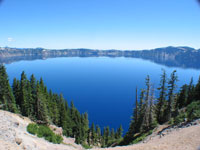Oregon
Link to home Link to Road Trip Index




















Our first stop was just across the border at Oregon Caves National Monument. Hiking down into the cave you feel the rapid temperature change from the warm sunny day at the surface to a chilling, damp, and dark 47 degrees at the bottom. From the tour guide we learned about features called cave popcorn and moonmilk. The moonmilk is this kind of wall slime that the German miners harvested and used for healing cuts and other minor wounds, and turns out to have one of the active ingredients used today in neosporine. It was a cool tour. Yeah - it was my first time in a cave like this before and i was just amazed. Really learned alot from the ranger tour guide. Just seeing all that underground stone growth which has been going on for ages is pretty unreal.
During that time the forest fires were raging in Oregon, the biggest in the States this year and ever in Oregon's history. Some 300 million acres have burned. The air was filled with smoke and flames could be seen on the hilltops. The image was so incredible the we pulled over to the side of the road to watch it. Many local residents were doing the same. Luckily we made it to Crater Lake in time to see its intense blue waters before the smoke came in and covered the place like a thick grey blanket. Other latecomers to the Lake weren't so lucky. The history on Crater Lake is that it used to be a volcano that blew its top and left a big crater in the mountain. Over the years the crater filled with water from snowmelt and rain and developed into the lake we see today. Also, it's good to note that there is no outlet for the lake. All the water that accumulates here stays here and only by evaporation does it lose any water. It's also the deepest lake in the country. When i first looked upon the lake - it just blew me away. It was so beautiful. Bluest of blue i've ever seen on a lake, and the huge crater walls that house the lake are just so impressive in their own right. Altogether I thought this place was rad. We spent the day there driving along the crater's rim and checking out the lake from different vantage points.
The rest of Oregon was purely coastal. We ambled along, stopping at botanical gardens and the great Oregon Dunes. We thought, living by the beach and all, that we'd seen our share of sand but those sand dunes were incredible. We felt like kids playing on them. We ran up to the top of many of them and Steve tried rolling down one. Your modern day Jack and Jill, only Steve didn't break his crown, just got sand in his pockets. The wind was howling and sand was blowing like a thick layer of fog over the dunes. It was quite a sight. Felt like we were in the middle of the Sahara dessert except the cold windy ocean was right there at the edge.
All the while we were keeping our eyes open for surf spots and followed a few cars with boards to some local longboard spots. Oregon, as with Northern Cal. has a much higher ratio of women surfers, we noticed. We also noticed the common practise of walking a good mile or two with board in hand to get to any surf spot. Same sport we're used to but a totally different culture surrounding it.
Tillamook cheese also comes from Oregon and the next time you're at the grocery store we'd like to recommend their pepper jack. It's been our favorite since our tour at the factory. The way they've got the packaging automated looks so precise and so perfect, it must be of German design.
Our last stop in Oregon was at Fort Clatsop, where Louis and Clark ended their expedition through the wild west. They had set up a fort here and were recording their observations to send back to the US government. The history was interesting but the clincher was the excavation findings going on while we were there. Researchers had uncovered some old nails, ceramic, and iron pots from 100 years ago and most were still in the ground when we got there. I guess they had used a huge magnet, waving it over the earth, looking for tremors, and that's how they discovered some of the metalwork underground. There was a whole team of researchers there taking measurements and writing descriptions. They also had demonstrations of how they lived out here back then. They showed how they made candles and lead bullets and they gave a demo on how to shoot those old style guns. DId you know that they had to carry 2 types of gunpowder back then? One to pack down the shaft with the lead bullet, and the other powder goes where the hammer hits the flint. When the flint powder flashes - that flame ignites the powder in the shaft and the bullet goes flying. For the demonstration they didn't use a real bullet - they used a big spit wad for a bullet. We were blown away and left Oregon feeling momentarily connected with the American forefathers. Onward to Washington and Olympic National Park.